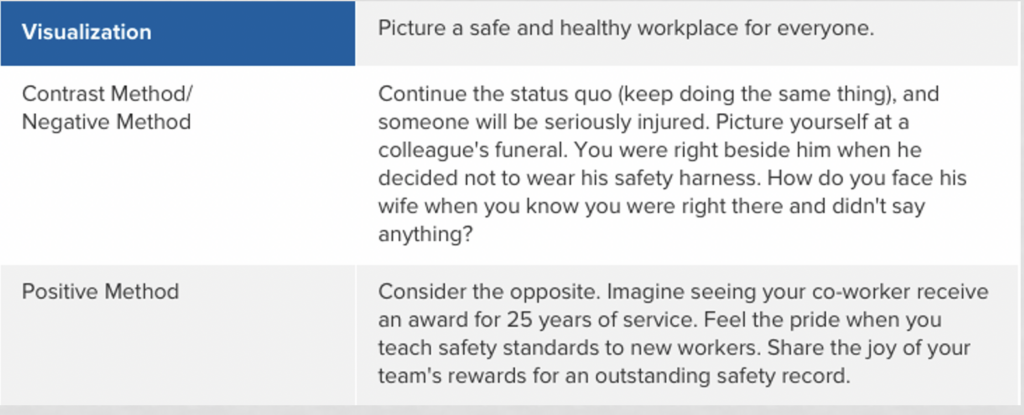If you followed instructions and read Monroe’s Motivated Sequence Part 1: A tried and true method of persuasion, then you should recognize the mysterious Dr. Monroe. (Seriously, this is the only picture I can find of Monroe on-line!)

Monroe is the genius behind Monroe’s Motivated Sequence, used in business and professional communication to persuade audiences. While there’s no 100% guarantee, I think you can see how following this sequence can increase your chances of persuading others. While in the future you may or may not follow MMS step-by-step, you should identify persuasive elements or concepts you can use in your future speeches, pitches and presentations. (Note: You MUST follow the sequence for your persuasive speech. Failure to do so will cost you BIG points!)
BTW – I had a student who challenged me about Monroe’s Motivated Sequence. He said Winston Churchill did have to follow MMS to influence his English countrymen during World War II. Frankly, I didn’t know if Churchill used MMS or not but I took the student’s statement as a challenge. I analyzed a couple of Churchill’s speeches including his Iron Curtain speech.
While it didn’t follow MMS in lock step, I could identify the basic MMS structure, the use of pathos and logos examples, along with other MMS elements in Churchill’s words. So there, smarty pants student! (I thought about using a more descriptive way of describe my smarty pants student, but this is a PG rated blog!)
A quick review of the first three MMS steps

So the MMS sequence starts with grabbing the audience’s attention and showing there is a reason to pay attention.
The second step establishes there is a problem or opportunity. This is an important step. If there isn’t a problem or opportunity to deal with, what are we all doing here?
The third step says, “Now that we all agree there’s a problem or opportunity, here’s what we’re going to do and why.” Just saying we need to fix it, isn’t persuasive. It’s too vague. You must champion your cause. Show them what steps need to be taken to bring about a solution to the problem. Prove to them you’re a leader with a plan.
Do you see how each step builds on the previous step? If you did any of the steps in a different order it just wouldn’t make sense. So let’s continue to build on Monroe’s Motivated Sequence by taking a look at steps 4 and 5.
Step 4: Visualization
I’m warning you right now. This is the step students most often skip in their persuasive speeches. I don’t know if it’s because they see the light at the end of the tunnel or they’re just anxious to get the speech over. The thing is the visualization step is a critical element in the sequence. It helps paint a picture in the audience member’s mind of what will or won’t happen if we don’t take some kind of action. So here’s a little hint… DON’T SKIP THIS STEP!
The visualization step accomplishes the following: It allows the audience to see the impact of your plan; it shows them how they will profit or be rewarded for following the plan (WIIFM); it creates a desire and motivates the audience to follow the plan.
For this step it is essential the you offer VIVID images and tap into your audience’s senses. How do you do this? Well, Dr. Monroe gives us three different strategies.
- #1 – Positive method. You provide vivid, concrete, positive descriptions of the future. You provide a probable situation and get the audience to picture themselves enjoying the plan. As a rule of thumb people respond best to the positive method. It gives them hope.
- #2 – Negative method. You describe the adverse conditions that will occur if we don’t take steps to solve the problem or take advantage of the opportunity. Paint a picture for the audience that shows them how dangerous or unpleasant the situation will be. Show them how it will “cost” them if they don’t take action. The negative method probably shouldn’t be your first choice. But sometimes you need to present the dark, ugly negatives to push the audience out of their comfort zone and into action.
- #3 – Contrast method. This combines both the positive and negative approaches. Visualize for the audience what will happen if they don’t follow the plan. Follow that with images of what will happen if they do follow the plan. It’s important to start with the negative and end with the positive scenario. (Again, it gives people hope.)

Let’s continue with our parking garage example. (BTW – none of you can use building a parking garage as your topic for the persuasive speech!)
- Positive method: Imagine students like Josh Anderson coming from their job, paying a parking fee and showing up for class before class starts. Imagine Josh being able to consult with his teammates of the status of their group project. Imagine Josh breathing normally, and not feeling calm because he made it to class on time. Imagine Josh focusing and putting the lecture in context because he could calmly sit down before the lecture started. Now imagine Josh’s story coming true for hundreds of CWU students who find parking an obstacle to them getting their education.
- Negative method: Remember Josh Anderson? The hard-working student just trying to get an education? What happens when he doesn’t land a scholarship or job because he got a poor grade in a critical class. A grade he didn’t deserve. It’s possible he may consider dropping out of school because getting to class on time stresses him out. What happens when he and all the other people trolling for a parking space approach the Board of Trustees demanding a solution to the problem? How do we look if CWU doesn’t have an answer?
- Contrast method: I want you to picture Josh Anderson. He’s the working student I told you about who was late to class. Can you see how the class reacts to the disruption he makes when he walks into class half-way through the lecture? See how he’s breathing hard and sweating because he had to run across campus. Picture how it takes him another 3 or 4 minutes after he takes his seat to pull out his notebook and pen to take notes. Think about how the professor and the students in the class feel about him interrupting class on a regular basis. Now picture Josh, calmly sitting in class. See him focusing on the lecture, asking questions, soaking up knowledge. Picture how well his team works together because he can contribute ideas and solutions in a timely manner. Now multiple Josh by hundreds of other CWU students who face the same situation every class day.
Notice how each method uses vivid words and images to paint the picture. You’ve got to say more than “Imagine Josh showing up for class on time.” Yes, that kinda paints an image but it’s more like a kindergartner’s stick people drawing versus a Van Gogh painting. One offers more detail than the other.

You can power up your visualization by tapping into one or more of the five senses, sight, smell, taste, touch and hearing. In my examples, I used sight, but I also tapped into hearing (breathing normally, the sound of Josh interrupting class by walking in late). I hinted at smell when I painted the picture of a sweaty Josh running across campus.
Visualization Example
Our safety example asks the audience to picture a safe workplace. In the contrast/negative method it asks the audience imagine if nothing is done. I especially think the image explain to a family member at the funeral how you could have saved their loved one from dying has real emotional punch. The positive version is positive, but I bet the safety majors can think of some stronger positive images.

Step 5: Call to Action
Now you’re in the home stretch! You’ve grabbed their attention, proved to them there is a problem or opportunity, shown them you have a solid plan to fix the situation and you’ve shown them what the world would be like if they did and/or didn’t take action. Now, we need to inspire them to get up out of their seats and give them something specific and tangible to do to make this thing happen.
Again, it needs to be specific. “Call or write your Congressional delegate” is too vague. I mean how many of you know who represents your district in Congress? How many of you know how to contact that person? How many of you desire to write a persuasive message to send them?
But if I say, “Here’s the email address for your representative in Congress. Just cut and paste this message (pre-written persuasive message) into your email. Press send. With that simple action, you’ve help us take the first step to solving this problem.”
One of the student outlines I asked you to analyze is about deforestation. For his action step, the speaker said he tried to get some trees from the National Arbor Society but they couldn’t ship the trees to him on time. He planned to give each student a tree to plant to fight deforestation. So, instead of a tree, he gave each person in the class a package of wildflower seeds. He said they could plant them at home, plant them in a flower box or just spread them in a field. While it wouldn’t be adding trees back into the environment, it did represent taking a small step toward adding vegetation back into our ecosystem. He also left the class with a link to the National Arbor Society so they could order trees for themselves.

Let’s jump back to our parking garage example. Possible action statement: “The student government has already signed on to supporting this project. Now we need to convince the Board of Trustees to take the next step. Here’s the URL for an on-line petition. I’ve already posted the URL on our Facebook page. All you need to do is click on the link, type in your name and CWU identification number to indicate you support the plan. When we get 2000 names on the petition we’ll present the project to the Trustees. They’ll have to listen if 2000 of us want the same thing. The next Board of Trustees meeting is three weeks from now. We hope to have enough signatures to get on the agenda. So, please, pull out your phones, click on the link and let’s start building a sensible and economical parking garage to solve CWU’s parking problem.”
Action step example
I love how the speaker gives everyone in the audience something immediate to do. Let’s take a tour after lunch and start identifying the problems. Even if they can’t do the tour, it plants the seed that anyone in the audience could put this plan in action by simply looking around and identifying the problems.

Of course, if I were the speaker, I’d make sure the company scheduled a follow up meeting to discuss what the problems and come up with a priority list. Otherwise the nothing more may be done other than identifying problems.
MMS: Useful in your personal life as well as your business and profession life
In my opinion the “Yeah, but what about…” and the Visualization steps represent the strongest parts of Monroe’s Motivated Sequence. The beauty and magic of MMS is how it builds on itself and guides, nudges, directs and even pushes the audience into taking the next step.
So, as you put together your persuasive speech outline, follow Monroe’s Motivated Sequence. Their may be some steps in your outline that are stronger than others. Using the MMS template you’ll find in the Monroe’s Motivated Squence assignments can help you identify the weak spots in your persuasive message. Fill those blank and/or weak spots in and you’ll hit your audience over the head with one persuasive argument.
BTW – You can use the MMS structure in your personal life. You could use a less structured version of the sequence to convince your parents to finance your trip to Cancun.
Or maybe you dig up a lot of facts and figures to logically convince your sweetie that it’s better to skip going to Cancun in order to put more money aside for a house. You could wrap up your argument by visualizing for them what it would be like to live in your own home. Again, no guarantees, but it can’t hurt!
Your assignment
Go back to Canvas and complete the Monroe’s Motivated Sequence 2 assignment. And don’t forget to complete the MMS 1 assignment as well. You’ll need to reference the Monroe’s Motivated Sequence Part 1 blog to complete that assignment.